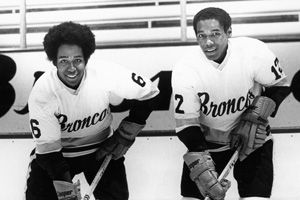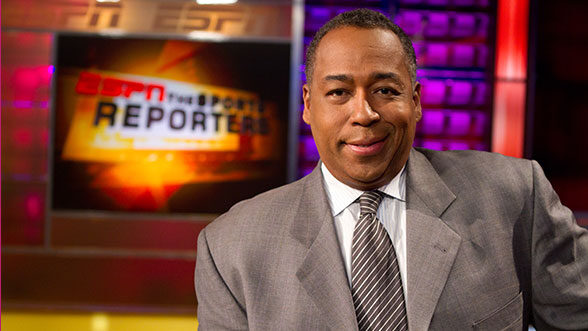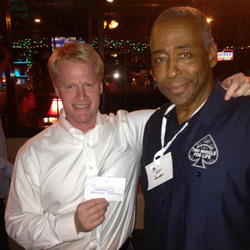Editor’s note: Sports fans mourned the loss of broadcaster and former athlete John Saunders in August 2016. But few who tuned into ESPN’s “The Sports Reporters” and ABC’s “College Football” knew the extent to which Saunders struggled with profound depression. Prior to his death at age 61 from natural causes, Saunders was collaborating with author John U. Bacon, BA ’86/MA ’94, on a candid memoir about his lifelong struggle. Below is an excerpt from Playing Hurt: My Journey from Despair to Hope. Readers may be surprised to learn that in 1973 U-M’s hockey coach Dan Farrell recruited Saunders to play hockey for Michigan.
Faceoff
With high school winding down, I had to make a big decision. Thanks to my banged-up shoulders, my drug use, and a couple lost seasons, my hockey prospects had dropped considerably. I’d visited the University of Michigan, but the feelers I’d previously received from Dartmouth, Princeton, and Providence College had all dried up.
My dad told me he knew someone at Indiana University, where they were planning to upgrade their hockey program from club to varsity status. Without any better offers, I decided to go to Indiana. But right before I left for Bloomington, the first week of August, 1973, the University of Michigan’s new head hockey coach, Dan Farrell, called me at home.
“John, this is Dan Farrell at Michigan. I just wanted to wish you good luck this year. And if you ever change your mind and want to attend Michigan, we’d love to have you.”
My heart went cold. “What are you talking about?”
“Well, frankly, I just don’t understand why you’d turn us down for a school that doesn’t even have a true varsity program.”
“I don’t know what you mean,” I said.
“Your father called me last week and told us you’re going to Indiana.”
I couldn’t believe what I was hearing. I tried to compose myself, and not screw up whatever might have been left to screw up.
“Coach, I don’t know anything about this. Can I call you back?”
“Sure,” he said, “but I need an answer today, because we’re about to give your spot to another recruit.”
I called my father and calmly asked about Coach Farrell’s call.
“Oh, I’d been meaning to talk to you about that,” he said casually. “You’ve got to go to Indiana. Michigan can’t give you a scholarship.”
“But I don’t want to go to Indiana.”
“You’ll do what I say, or else you can forget all about college. You’re going to Indiana!”
I put down the phone, and started to cry, then pulled myself together and called Coach Farrell. I had three choices: I could follow my dad’s orders; I could say yes to Michigan’s offer of walking on; or I could forget about college, and try out for one of the junior teams and try to get to the NHL that way.
Check to the soul
My confidence was so low that I decided to take the path of least resistance. I didn’t have the energy to fight with my dad again, and being a big fish in a little pond might have some advantages. So I told Coach Farrell I appreciated his offer, but I’d be going to Indiana after all. He sounded surprised, but he told me to keep in touch, and if I ever changed my mind to let him know, and he’d see what he could do.
I packed up my few belongings and my hockey equipment, hopped in my dad’s car, and headed for Bloomington. Indiana University has a gorgeous campus, filled with friendly Midwestern folks, and stately limestone buildings you might have seen in the cult classic Breaking Away.
After my dad left, I finally got a ride out to the rink, which was far off-campus: a rickety, three-sided building with something that looked like a hockey rink inside. I saw a sign that said, “HOME OF THE INDIANA HOOSIERS.” It was their rink, all right. My jaw dropped. This was basically an outdoor arena with three walls, and about a thousand seats. Meanwhile, five hours northeast in Ann Arbor, the University of Michigan was converting its famed Yost Field House into an 8,000-seat arena, now considered one of college hockey’s best barns.
I returned to campus, found my dorm room, threw my bag down, and flopped on the bed, defeated. I was wondering when my roommate was going to check in when I heard a key turn in the door. The door swung open, and in walked a huge kid, who had to be a lineman on the football team, followed by his parents. I stood up and held out my hand to greet him. “Hey, I’m John, from Montreal. I’m a hockey player.”
All three of them stopped in their tracks. No one shook my outstretched hand.
”I’m not staying with no f***in’ n***er!” the kid said, to his parents. “Can’t believe Coach roomed me with a goddamn darkie!”
His father tried to calm him down. “Don’t worry, son, we’ll get this straightened out.”
They talked about me as if I was in another room.
“I mean, I know I have to play with them,” the son said, “but I don’t have to live with them.”
I turned to the mother for a sympathetic look, figuring she was my best chance. She made for the door. “Let’s get out of here,” she said.
Light the lamp
In Canada, racists like that were like dinosaurs. You heard about them, but you didn’t think they still existed. I had never tasted real racism until I set foot in that Indiana dorm room. I picked up the phone and called Coach Farrell at Michigan.
“Coach, this is John Saunders. Do you still want me to come to Michigan?”
“Absolutely,” he said. He explained that I’d have to come as a walk-on, with no scholarship money, but if I made the team, he’d see what he could do. I had no idea how I would pay for school, but I was desperate, so I told him I was coming regardless.
“Great!” he said, and promised to meet me at the bus station.
When I phoned my father, he exploded. “Why can’t you do anything right? Don’t expect a damn dime from me. You’re on your own!”
I hung up.
I loaded up my bags and got on a Greyhound. Just as he’d promised, Dan Farrell was there to greet me in Ann Arbor — a welcome sight. He dropped me off at the Bell Tower Hotel, which is where the musical stars stay before they perform right across the street in Hill Auditorium. Farrell said he’d try to find me a dorm room as soon as possible. No guarantees, but his good intentions were clear. Farrell was a man I felt I could trust.
After a few days in the hotel, I moved into a dorm on the other side of campus, far from the rest of the freshmen. I met them the next day for dry-land training. I was now part of something big. No one has won more NCAA hockey titles than Michigan, and the University speaks for itself. Even though I was a latecomer, the guys on the team were great. Most of them were fellow Canadians, and the American guys wanted to act like Canadians. After all, hockey is our sport!
Special teams
A week into the fall semester we had to take physical exams the same day the basketball players did. They seemed curious about this black guy lined up with all of the white hockey players. Campy Russell, the basketball team’s star player, and the nephew of Michigan all-time great, Cazzie Russell, approached me and said, “You’re a hockey player?” I nodded shyly, not sure what was coming next. Then he asked, “Man, how can you stand up with those knives on your feet?” Both teams busted out laughing.

Saunders and his brother Bernie both played hockey for Western Michigan University. (Photo: WMU Athletics.)
We started dry-land training about six weeks before we hit the ice. We ran sprints, we ran distance, and we lifted weights. Dan Farrell, Wisconsin’s Bob Johnson, and Minnesota’s Herb Brooks were all way ahead of their NHL counterparts, on and off the ice. College hockey was entering a golden era, and these guys were leading the way.
When we got to dress for our first practice in the former Yost Field House, built in 1923, I was so excited I dressed quicker than everyone else, so I could be the first Michigan player to step on the ice at the newly converted Yost Arena.
I was in for a shock. I had always been the biggest guy on my teams, but most of these guys were at least as big as I was, and they all moved at a speed I’d never seen before. We had a large freshman class of 10 guys, five of whom would go on to play a combined 32 years in the National Hockey League, part of the first wave of college players to break into the NHL. I had joined some pretty fast company, and I was struggling just to keep up.
Because my dorm room was so far away, two other freshmen — fellow Canadians Dave Shand and Rob Palmer — let me crash on their floor. Compared to living with a racist roommate, even sleeping on their dorm-room floor was quite an improvement. I could eat in their cafeteria, too, thanks to Dave. We were about the same size, but he was white with shoulder-length hair, and I was black, with a big afro. He’d get in line before me, flash his meal card to the guy checking at the door, then pass it back to me, and I’d use it. The guy checking either had really bad vision, or he was happy to play along. I’ve always assumed it was the latter.
Coming off my brief experience at Indiana, this felt great.
Excerpted from Playing Hurt: My Journey from Despair to Hope by John Saunders with John U. Bacon. Copyright ©2017. Available from Da Capo Press, an imprint of Perseus Books, LLC, a subsidiary of Hachette Book Group, Inc.
(Top image: John Atashian, ESPN.)






Amy (Olszewski) Cambareri - 2001
Wow. This sounds like a must-read. Thank you, John Bacon, for helping to share John’s story. Depression sucks and I am glad John found a sense of hope, which can be difficult but is so important!
Reply
Kristin Kaleniecki Booth - 1994
I cannot wait to read this!!! Well done John!! And for some reason I thought you were going to be a high school teacher!! You are a phenomenal writer!!
Reply
Deborah Freund - 1975, 1975, 1980
There will be so many lessons in this book. When will it be out? I look forward to reading it.
Reply
Deborah Holdship
It’s out now. See the link in the intro copy.
Reply
Michael Griffin - 1986
I’m already sucked in. I’ve read all of John Bacon’s book. Great subjects. Great writing. Great stories.
Reply
gary hornfisher - '98 + '99
John B. – Love your work! Looking forward to reading your latest, when it is realeased.
Also, enjoyed the work of John S. Miss watching him on Sunday mornings…
Go Blue!
Reply
Delia Leggett Jacob - 1975
Fantastic writing. It transports me to an intimate exchange where this amazing story is being told. Indiana U, shame on you for allowing the football racist admission to your team and to bruise the ego of a talented, sensitive frosh. Hope that guy regrets his opportunity to know Saunders and change his thinking.
Reply
Ramona Bashshur - 1984
Compelling excerpt. I will be getting the book asap.
Reply
Roger Szafranski
Being a student athlete under Bo in the ’70s was a tremendous task! The emotions, anxiety, depression and a vast array of psychological diagnosis were abundant — this article doesn’t even scratch the surface.
Maintaining your grades and competing with other students whose job it was to just go to school, the student athlete like me and other football players were required to be finished with our classes and in the locker-room by 2:30 to watch practice films from the previous day’s practice. Afterwards as a defensive lineman we were required to lift weights, get taped and dressed to be on the practice field half an hour before practice and run through drills. Practice involved two grueling hours of running plays in preparation for Saturday’s game. After practice, we had to rush to shower, dress, and get up to the Student Union where we had training table in the basement of the Student Union. Now its 7:00 and time to study if we did not have to go back to the football building for treatment for some injury. Now after a full day like that how much time and energy can you devote to actually studying? Not a lot. By 9:00 you were dead tired and nodding off; and tomorrow morning you have to get up and do it all over again.
Now if this schedule was just the football season it would be one thing, but after the season were preparations for the Bowl game, then winter workouts throughout the winter, which ran into spring ball, which lasted until the end of the semester. Summer vacation, forget it. If you expected to play you were expected to stay the summer in Ann Arbor working out with the team. And of course, the NCAA doesn’t allow organized workouts, but miss one of them and you get a call from Bo’s secretary Lynn summoning you to Bo’s office. Not a pretty picture!
So think about this the next time any of you students that look down your noses at the student athlete and sarcastically cuss them out because they are on a scholarship. It’s not just running out of the tunnel on a Saturday afternoon…believe me.
Reply